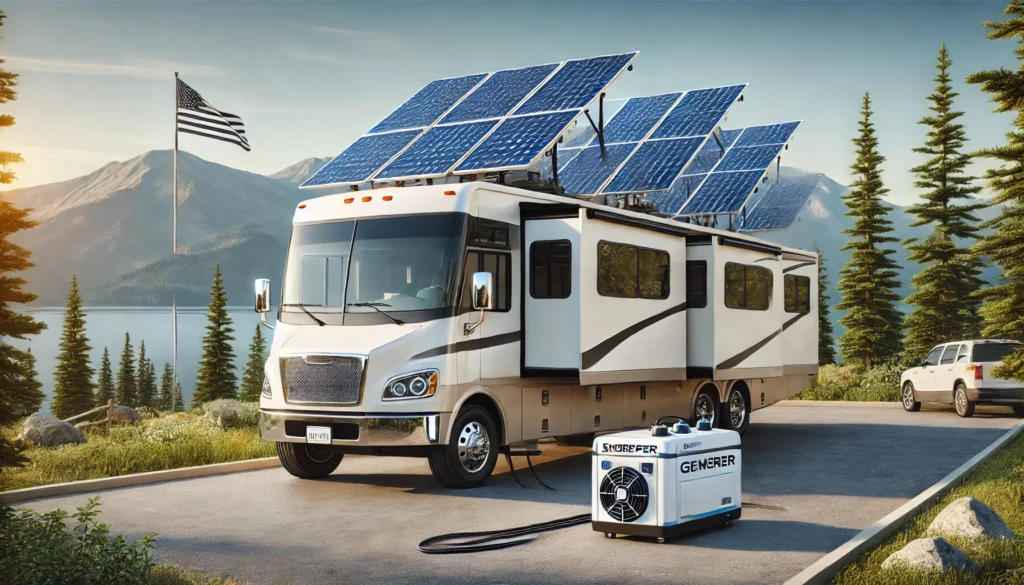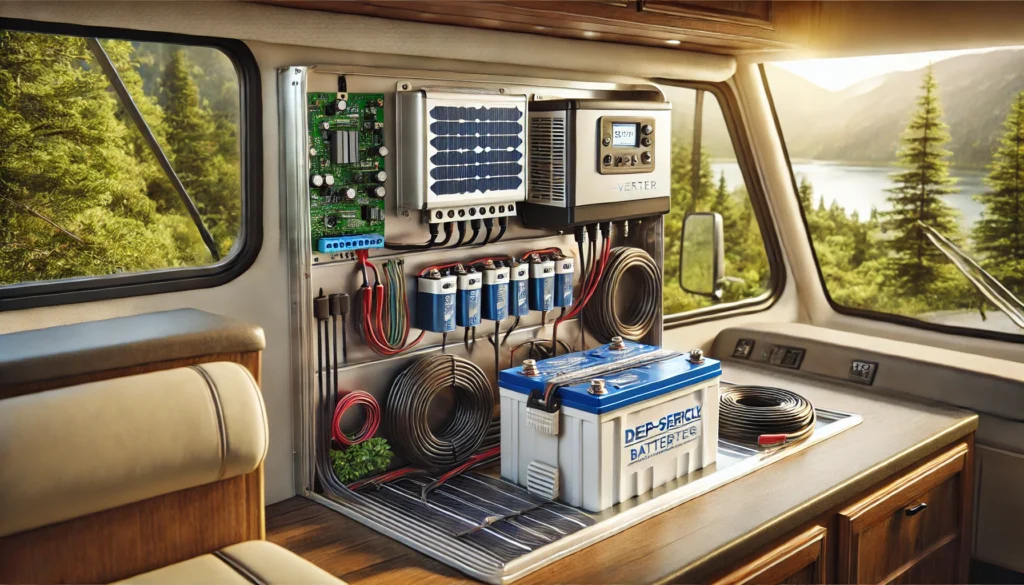🔌 Understanding RV Power Basics
Living in an RV means managing power wisely, whether you’re plugged into shore power, using solar, or running a generator. This guide breaks down essential electrical tips to keep your adventures powered up.
⚙️ 1. Know Your RV’s Power Capacity
Before plugging in, understand your RV’s power system:
⚡ Watts = Volts × Amps
📌 Example for a 30-Amp RV:
120V × 30A = 3,600W
📌 Example for a 50-Amp RV:
120V × 50A × 2 (dual-phase)* = 12,000W
*a 50-amp RV plug actually has two 50-amp legs, each supplying 120 volts.
| RV Electrical System | Max Amps | Max Watts |
|---|---|---|
| 30-Amp System | 30A | 3,600W |
| 50-Amp System | 50A | 12,000W |
🔹 Tip: Check your RV’s manual to confirm your system and avoid overload.
💡 Explore More: How do voltage and amperage affect your RV’s power supply?

⚡ 2. Use a Surge Protector
A surge protector prevents damage from voltage spikes when plugging into shore power.
✅ Protects against power surges
✅ Helps prevent electrical fires
✅ Recommended: EMS (Electrical Management System) for full protection
💡 Explore More: What are the risks of unprotected shore power connections?

🔋 3. Balance Your Power Usage
To avoid tripping breakers, manage high-wattage appliances:
🚫 Avoid running these together:
❌ Air Conditioner + Microwave
❌ Water Heater + Coffee Maker
✅ Power-Saving Tips:
✔️ Use energy-efficient LED lights
✔️ Turn off appliances when not in use
✔️ Install a power monitor

💡 Explore More: How can energy-efficient appliances improve RV power management?

☀️ 4. Go Solar for Off-Grid Power
Solar panels let you stay powered without shore power!
🔆 Recommended Solar Setup:
🔹 200W-400W solar panels (for essentials)
🔹 Lithium or AGM batteries (for better storage)
🔹 Solar charge controller (for safe charging)
💡 Explore More: What’s the best battery type for storing solar energy in an RV?

🔋 5. Maintain Your Batteries
Keep your RV batteries healthy for longer use:
| Battery Type | Maintenance | Lifespan |
|---|---|---|
| Lead-Acid | Check water levels, avoid deep discharges | 3-5 years |
| Lithium | Minimal maintenance, charge efficiently | 8-15 years |
✅ Tip: Avoid draining below 50% for lead-acid and 20% for lithium.
💡 Explore More: What’s the lifespan difference between lithium and lead-acid RV batteries?

🔄 6. Use an Inverter for AC Power
Inverters convert battery power (DC) into AC power for standard appliances.

⚡ Choosing the Right Inverter:
🔹 1,000W – Small electronics (laptop, phone)
🔹 2,000W+ – Larger appliances (microwave, coffee maker)
🔹 Pure Sine Wave – Best for sensitive electronics
💡 Explore More: How do sine wave inverters improve power efficiency?

🚫 7. Reduce Phantom Loads
Many devices use power even when turned off!
🔹 Phantom Load Devices:
❌ TVs, Chargers, Microwaves, Clocks
✅ Power-Saving Hacks:
✔️ Unplug devices when not in use
✔️ Use smart power strips
✔️ Install a battery disconnect switch for storage
💡 Explore More: How much power do standby devices waste in an RV?

📚 Resources for RV Power Management
🔗 Useful Guides & Tools
✅ Understanding Surge Protectors – Hughes Autoformers
Protect your RV’s electrical system with surge protectors and power management devices.
✅ Solar Power for RVs (Amazon)
✅ Battery Maintenance Tips (Renogy)
🚀 Stay Powered, Stay Adventurous!
Managing your RV’s power doesn’t have to be complicated. Follow these simple tips to keep your journey charged, efficient, and worry-free!








